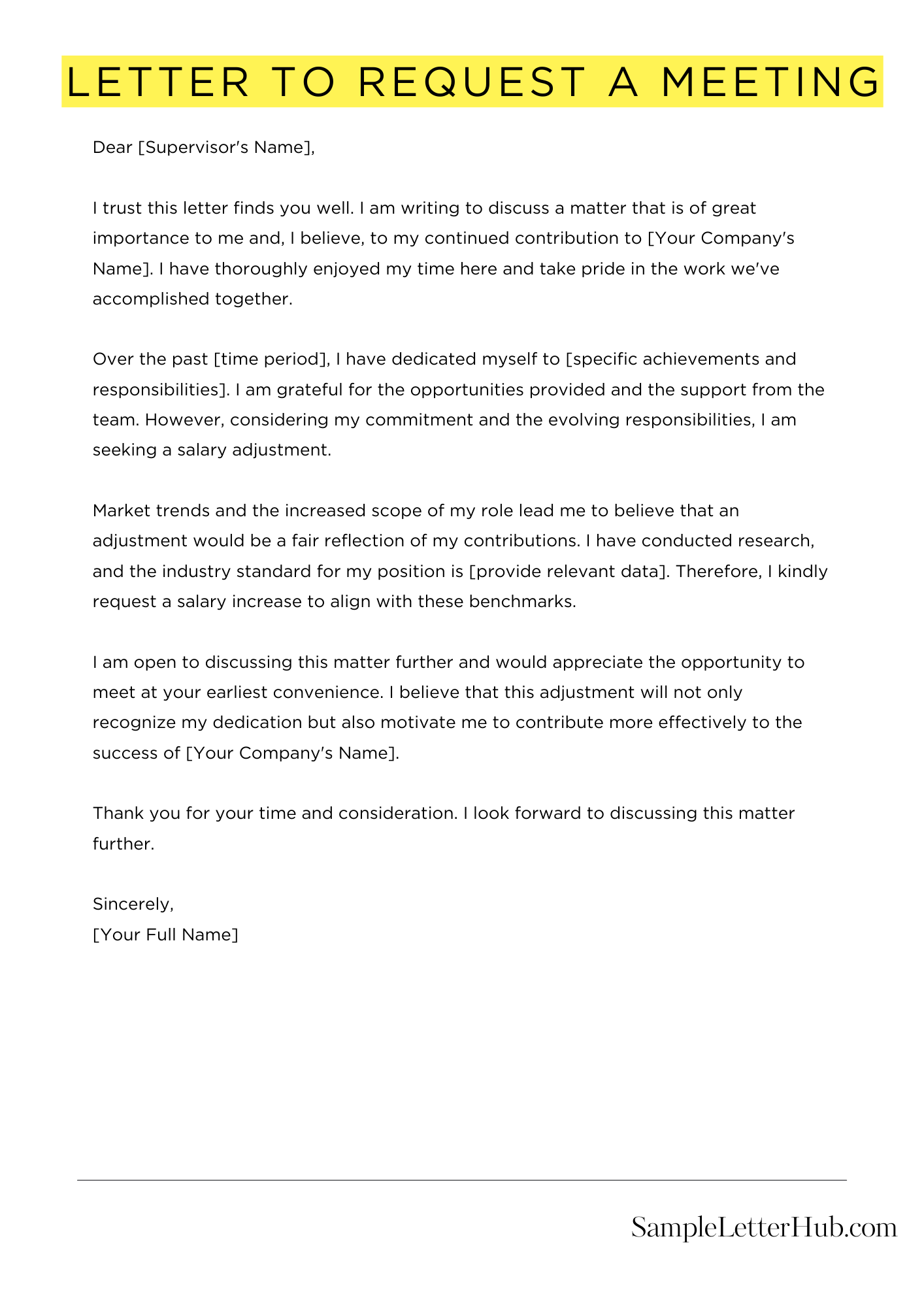A Letter To Request A Meeting is a formal letter written to request a meeting with someone. It is typically used to request a meeting to discuss a specific topic or issue.
In this article, we will share some templates/examples/samples of Letter To Request A Meeting. These templates/examples/samples will help you to write a clear and concise letter that will get you the meeting you need.
Request for a Meeting
Dear [Recipient’s Name],
I hope this letter finds you well. I am writing to request a meeting to discuss [briefly state the purpose of the meeting].
I believe that a meeting would be beneficial as it would allow us to:
* Explore the topic in more detail
* Discuss potential solutions
* Identify areas of collaboration
I am available to meet on [list of available dates and times]. Please let me know if any of these times work for you.
Alternatively, if you have any other availability, please feel free to suggest a time that would be convenient for you.
I look forward to hearing from you soon and scheduling a meeting to discuss this matter further.
Thank you for your time and consideration.
Sincerely,
[Your Name]

How to Write a Letter to Request a Meeting
A letter requesting a meeting is a formal communication used to request a meeting with an individual or group. It is important to write a clear and concise letter that outlines the purpose of the meeting, the desired attendees, and the proposed date and time.
1. Start with a Professional Salutation
Begin your letter with a professional salutation, such as “Dear [Recipient’s Name].” If you do not know the recipient’s name, you can use a more general salutation, such as “To Whom It May Concern.”
2. State the Purpose of the Meeting
In the first paragraph, clearly state the purpose of the meeting. Be specific and provide enough detail so that the recipient understands the reason for the meeting.
3. Identify the Desired Attendees
List the desired attendees for the meeting. If there are specific individuals you would like to attend, name them. If the meeting is open to all interested parties, state that.
4. Propose a Date and Time
Propose a date and time for the meeting. Be flexible and offer multiple options to accommodate the schedules of the attendees.
5. Request a Response
Request a response from the recipient by a specific date. This will help you determine if the meeting is feasible and make necessary arrangements.
6. Express Appreciation
Express your appreciation for the recipient’s time and consideration. Thank them for their attention to your request.
7. Close with a Professional Signature
Close the letter with a professional signature, including your typed name and title (if applicable). Use a formal closing, such as “Sincerely” or “Respectfully.”
FAQs about Letter To Request A Meeting
1. What is the purpose of a letter to request a meeting?
A letter to request a meeting is a formal way to ask someone to meet with you to discuss a specific topic. It can be used to request a meeting with a potential client, a colleague, or a supervisor.
2. What should I include in a letter to request a meeting?
A letter to request a meeting should include the following information:
- Your name and contact information
- The name and contact information of the person you are writing to
- The date
- A brief explanation of the purpose of the meeting
- A list of possible dates and times for the meeting
- A closing paragraph that thanks the person for their time and consideration
3. How should I format a letter to request a meeting?
A letter to request a meeting should be formatted in a professional manner. It should be typed on letterhead and should be single-spaced. The font should be easy to read, and the margins should be 1 inch on all sides.
4. What is the best way to send a letter to request a meeting?
The best way to send a letter to request a meeting is to mail it to the person you are writing to. You can also send it via email, but be sure to include a formal subject line.
5. What should I do if I don’t receive a response to my letter?
If you don’t receive a response to your letter within a week, you can try following up by phone or email. Be polite and professional, and don’t be afraid to ask if the person received your letter.

